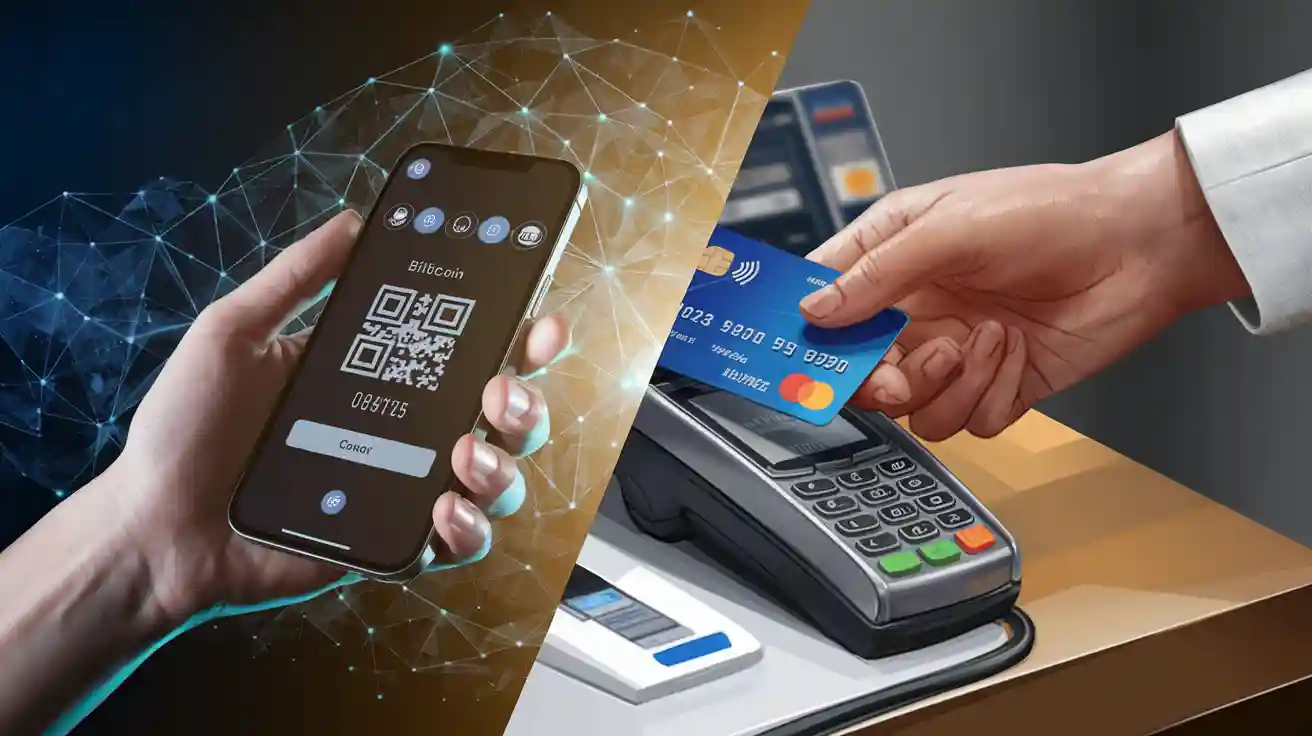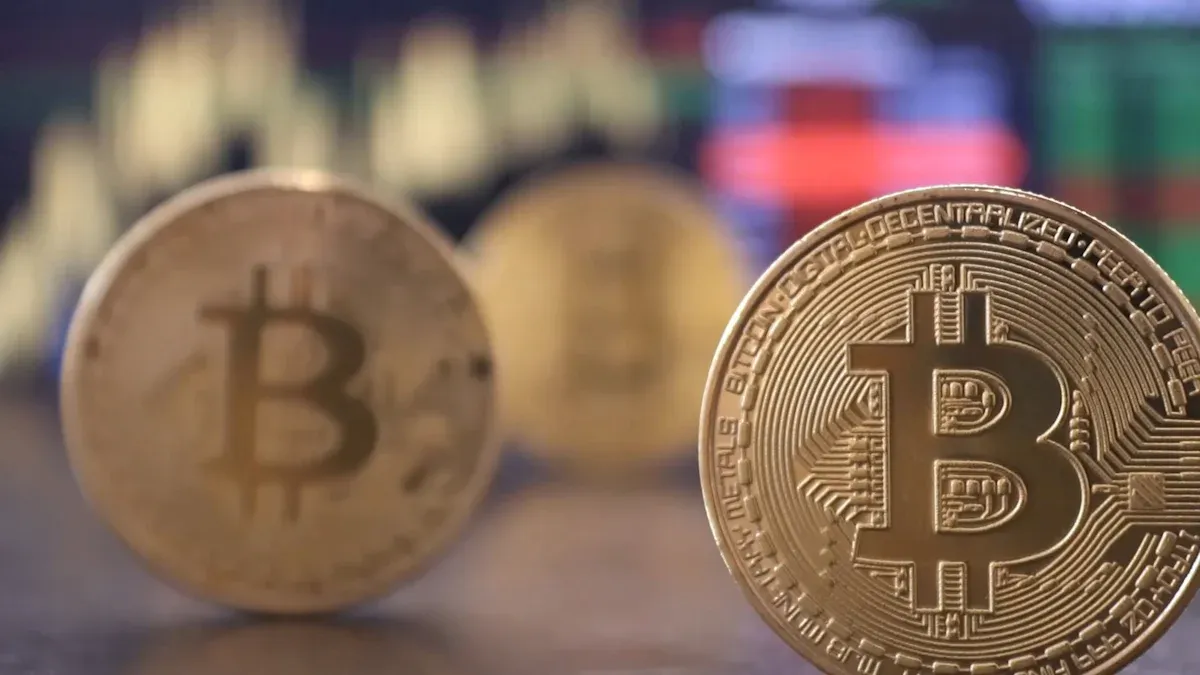What Similarities and Differences Do You See Between a Bitcoin Transaction and a Debit Card Transaction?
2025-05-07 09:08:38
Digital transactions have revolutionized how people handle money. Both bitcoin transactions and debit card transactions enable seamless digital payments, but they operate through vastly different mechanisms. Bitcoin relies on blockchain technology, offering decentralization and transparency. Debit card payments, on the other hand, use centralized banking systems to process transactions. These differences, along with shared goals of efficiency and convenience, highlight the fascinating contrasts and parallels between the two. Understanding what similarities and differences do you see between a bitcoin transaction and a debit card transaction can help users navigate the evolving financial landscape.
Fees in Bitcoin and Debit Card Transactions
Comparing Transaction Costs
The cost of transactions varies significantly between bitcoin and debit card payments. Bitcoin transactions often involve fees that depend on the platform or method used. For instance, online exchanges typically charge between 0.1% and 1%, while Bitcoin ATMs impose higher fees, ranging from 5% to 10% per transaction. In contrast, debit card transaction fees are generally lower, falling between 1.10% + $0.10 and 3.15% + $0.10. These fees are comparable to those of credit card transactions, making debit cards a more cost-effective option for everyday digital payments.
Bitcoin's fee structure can also fluctuate based on network congestion. During periods of high activity, fees may rise as users compete to have their transactions processed quickly. On the other hand, debit card fees remain relatively stable, as they are determined by banking institutions and payment networks rather than market demand. This stability makes debit cards a predictable choice for users seeking consistent transaction costs.
Factors Influencing Fees
Several factors influence the fees associated with bitcoin and debit card transactions. For bitcoin, network congestion plays a significant role. When the blockchain experiences heavy traffic, miners prioritize transactions with higher fees, leading to increased costs for users. Transaction complexity also affects fees, as more data-intensive transactions require greater computational resources. Additionally, operational costs, such as those associated with running Bitcoin ATMs, contribute to the higher fees charged by these machines.
Debit card fees, on the other hand, are influenced by factors such as location and transaction volume. For example, merchants in high-traffic areas may face higher operational costs, which can indirectly affect the fees passed on to consumers. Time of transaction can also impact costs, as some payment networks charge higher fees during peak hours. However, these variations are generally less pronounced than those seen in cryptocurrency transactions.
Cost Implications for Users
The fee structures of bitcoin and debit card transactions have distinct implications for users. Bitcoin fees can range from as low as $0.01 to $0.10 when using Layer-2 solutions like the Lightning Network, making it an attractive option for microtransactions. However, during periods of high network congestion, fees can rise to $1-$5 or more, potentially deterring users from making smaller payments. In contrast, debit card fees remain relatively consistent, offering a reliable option for everyday purchases.
For users engaging in international transactions, bitcoin may provide a cost advantage. Traditional banking systems, such as Citibank, charge significant fees for wire transfers, with domestic transfers costing around $35 to send and $15 to receive. Bitcoin's decentralized nature eliminates the need for intermediaries, reducing costs for cross-border payments. However, users must weigh these benefits against the potential for fluctuating fees during peak periods.
Ultimately, the choice between bitcoin and debit card transactions depends on individual priorities. Those seeking lower costs for international payments or microtransactions may find bitcoin appealing, while users prioritizing stability and predictability may prefer debit cards.
Speed of Payments
Bitcoin Transaction Times
Bitcoin transactions rely on blockchain technology, where miners validate and add transactions to the network. On average, the Bitcoin network aims to add a new block approximately every 10 minutes. However, the actual confirmation time can vary significantly. For everyday transactions, users typically wait for 1-6 confirmations, which may take anywhere from a few minutes to an hour. High-value transactions often require six or more confirmations to ensure security, leading to longer wait times.
The decentralized nature of bitcoin introduces variability in transaction speeds. Factors such as network congestion and transaction fees play a critical role. During peak periods, users offering higher fees see faster processing, while those with lower fees may experience delays. Despite these challenges, advancements like the Lightning Network have improved transaction speeds for smaller payments, making bitcoin more practical for microtransactions.
Debit Card Transaction Times
Debit card transactions operate through centralized banking systems, enabling near-instantaneous processing. When a user swipes or taps their card, the payment network verifies the transaction, checks account balances, and approves the payment within seconds. This speed makes debit cards a preferred choice for everyday purchases, especially in retail and online settings.
Unlike bitcoin, debit card payments do not require multiple confirmations. The centralized infrastructure ensures consistent processing times, regardless of the transaction amount. However, external factors such as system outages or high traffic during peak shopping hours can occasionally cause minor delays.
Factors Affecting Speed
Several factors influence the speed of both bitcoin and debit card transactions:
- Network Congestion: Bitcoin's limited capacity can lead to delays during high demand. Debit card networks, while more scalable, may also experience slowdowns during peak usage.
- Transaction Fees: Higher fees incentivize bitcoin miners to prioritize transactions, while debit card fees have minimal impact on speed.
- Miner Availability: The number of active miners affects bitcoin processing times. Debit card systems rely on robust infrastructure, minimizing such dependencies.
- Transaction Size: Larger bitcoin transactions take longer to process, whereas debit card payments remain unaffected by size.
- Time of Day: Bitcoin transactions may process faster during off-peak hours. Debit card networks generally maintain consistent speeds but can slow down during major events or holidays.
| Payment Network | Daily Transaction Volume | TPS (Transactions Per Second) |
|---|---|---|
| Bitcoin (BTC) | $32.14 billion, 570,000 transactions | 7 |
| Visa | $46 billion, 720 million transactions | 1700 |
Bitcoin's decentralized nature and reliance on miners introduce variability in transaction speeds. In contrast, debit cards benefit from centralized systems, ensuring faster and more predictable processing. Users must weigh these differences when choosing between cryptocurrencies and traditional payment methods.
Security in Bitcoin and Debit Card Transactions

Privacy and Anonymity
Bitcoin transactions prioritize privacy and anonymity, offering users a level of discretion not typically available with traditional payment methods. When individuals use bitcoin, their identities remain pseudonymous. Instead of personal information, the blockchain records transactions using alphanumeric wallet addresses. This feature appeals to users who value privacy in their financial dealings. However, while bitcoin provides anonymity, it is not entirely untraceable. Advanced blockchain analysis tools can sometimes link wallet addresses to real-world identities, especially when users interact with regulated exchanges.
Debit card transactions, in contrast, lack anonymity. These payments require users to share personal and financial details, such as their name, card number, and billing address. Banks and payment processors store this information, making it accessible to authorized parties. While this transparency helps prevent fraud, it also raises concerns about data privacy. Users must trust financial institutions to safeguard their sensitive information from breaches or misuse.
Fraud Prevention Measures
Both bitcoin and debit card systems implement measures to enhance security and prevent fraud. Bitcoin relies on blockchain technology, which ensures that all transactions are immutable and transparent. Once a transaction is confirmed, it cannot be altered or reversed. This feature reduces the risk of fraudulent chargebacks, a common issue in traditional payment systems. Additionally, private keys protect users' crypto wallets, ensuring that only the rightful owner can authorize transactions. However, the responsibility for securing private keys lies solely with the user. Losing access to a private key can result in the permanent loss of funds.
Debit card systems employ centralized fraud prevention mechanisms. Banks and payment networks monitor transactions for suspicious activity, such as unusual spending patterns or unauthorized access. Many debit cards also offer features like two-factor authentication and real-time alerts to enhance security. In cases of fraud, users can dispute charges and often receive reimbursement. While these measures provide a safety net, they also rely on centralized control, which may not appeal to users who prefer the decentralized nature of cryptocurrencies.
Risks and Vulnerabilities
Despite their security measures, both bitcoin and debit card transactions face risks and vulnerabilities. Bitcoin users are susceptible to phishing attacks, malware, and scams targeting their private keys or wallet credentials. The irreversible nature of bitcoin transactions means that victims of fraud or theft have limited recourse. Additionally, the decentralized nature of cryptocurrencies makes them attractive to cybercriminals seeking to exploit security loopholes.
Debit card transactions, while more familiar to most users, are not immune to risks. Card skimming, data breaches, and identity theft remain prevalent threats. Hackers often target centralized databases containing sensitive user information, leading to widespread financial losses. Furthermore, debit card users may face unauthorized charges if their card details are compromised. Although banks typically offer fraud protection, the resolution process can be time-consuming and stressful.
Accessibility and Adoption of Payments
Global Reach of Bitcoin
Bitcoin has gained traction worldwide, driven by its decentralized nature and ability to bypass traditional banking systems. Millennials, aged 25–40, lead the charge in adopting cryptocurrencies, often citing distrust in conventional financial institutions. Gen Z, the younger cohort, is rapidly embracing bitcoin through mobile apps, while older generations, such as Boomers, are entering the market via investment vehicles like ETFs and IRAs.
The global adoption of bitcoin extends beyond individuals. Over 60% of on-chain transactions involve retail wallets holding less than 1 BTC, highlighting its appeal to everyday users. Institutional players, managing wallets with over 1,000 BTC, are also increasing their stake in the cryptocurrency market. On a national level, countries like El Salvador have adopted bitcoin as legal tender, showcasing its potential as a mainstream payment method. Additionally, the Lightning Network has emerged as a game-changer, enabling instant and low-cost bitcoin transactions, making it a viable alternative to traditional debit card systems.
Widespread Use of Debit Cards
Debit cards remain one of the most widely accepted forms of payment globally. Their integration into existing banking systems ensures accessibility for users across various demographics. Retailers, both large and small, accept debit cards, making them a convenient option for everyday purchases. The simplicity of swiping or tapping a card appeals to consumers, while merchants benefit from streamlined payment processing.
Unlike cryptocurrencies, debit cards do not require users to navigate complex technologies. This ease of use has contributed to their widespread adoption, particularly in regions with established banking infrastructure. Debit cards also offer additional features, such as fraud protection and real-time transaction alerts, which enhance user confidence.
Barriers to Adoption
Despite their growing popularity, both bitcoin and debit card systems face barriers to adoption. Many small and medium-sized enterprises (SMEs) hesitate to eliminate cash due to economic concerns. The upfront costs of implementing digital payment systems can be prohibitive, especially for smaller businesses. In some regions, customer preferences for cash transactions persist, further slowing the shift to digital payments.
Bitcoin adoption encounters unique challenges. Its reliance on internet connectivity and technical knowledge can deter users in underbanked or rural areas. Additionally, the volatility of cryptocurrencies raises concerns about their suitability for everyday transactions. Addressing these barriers will be crucial for expanding the adoption of both payment methods.
Technology and Decentralization

Blockchain and Bitcoin
Blockchain technology forms the backbone of bitcoin and other cryptocurrencies. It operates as a decentralized ledger, recording transactions across a distributed network of nodes. This structure ensures transparency, as every transaction is publicly accessible, and enhances integrity and security by making data tamper-proof. Blockchain also supports decentralized finance, enabling peer-to-peer payments without intermediaries. Features like smart contracts automate processes, reducing reliance on centralized authorities.
However, blockchain faces challenges in scalability and performance. The immense volume of records complicates data extraction and analysis, impacting transaction speeds. Despite these limitations, advancements like sharding and encryption improve efficiency and security. Peer-to-peer networks further enhance resilience by distributing resources across multiple nodes, ensuring the system remains operational even during high demand.
Centralized Systems and Debit Cards
Debit card systems rely on centralized infrastructures managed by banks and payment processors. These systems streamline transactions by verifying and processing payments through a central authority. This approach ensures quick decision-making and user-friendly interfaces, making debit cards a preferred choice for everyday digital payments. Centralized systems also simplify compliance processes, reducing operational costs for businesses.
However, centralization introduces vulnerabilities. A single point of failure, such as a server breach, can compromise the entire network. Hackers often target these systems, leading to data breaches and financial losses. While robust security measures mitigate risks, the reliance on central authorities limits user control and exposes sensitive information to potential misuse.
Decentralization vs. Centralization in Payments
Decentralization offers users greater freedom and control over their funds. Decentralized systems like bitcoin eliminate intermediaries, reducing transaction fees and enhancing security. Cryptocurrencies operate on community-driven governance, ensuring equal participation among network members. This structure minimizes systemic risks, as no single entity holds control. Decentralized finance also empowers users by enabling them to manage cryptocurrency wallets independently.
In contrast, centralized systems excel in scalability and performance. They process transactions faster due to streamlined operations and centralized decision-making. However, they lack the transparency and auditability of decentralized networks. Centralized systems remain vulnerable to breaches, while decentralized networks distribute control, enhancing resilience. Users must weigh these trade-offs when choosing between centralized and decentralized payment methods.
| Aspect | Centralized Systems | Decentralized Systems |
|---|---|---|
| Advantages | User-friendly interfaces, quick decision-making, streamlined compliance processes, reduced operational costs | Enhanced security, user control over funds, lower transaction fees, censorship resilience |
| Disadvantages | Security risks, lack of user control, single points of failure | Lower transaction speeds, complexity for newcomers, higher maintenance costs, regulatory hurdles |
| Security | Vulnerable to data breaches and cyber-attacks | More resilient to attacks due to distributed control |
| Control and Governance | Central authority controls the network | Equal control among participants, community-driven governance |
| Scalability and Performance | Faster scalability due to centralized control | Shared responsibility among multiple nodes enhances scalability |
Decentralization prioritizes user autonomy and security, while centralization focuses on efficiency and ease of use. Both approaches have unique strengths and weaknesses, making them suitable for different use cases.
Bitcoin and debit card transactions both aim to simplify digital payments, yet their approaches differ significantly. Bitcoin offers decentralization, privacy, and innovation, appealing to users seeking autonomy and cross-border efficiency. Increased adoption and technological advancements have bolstered its credibility, while innovations like the Lightning Network improve transaction times and reduce costs. However, scalability issues and technical complexities remain barriers to crypto adoption, particularly for smaller businesses and regions reliant on traditional banking.
Debit cards, in contrast, excel in speed, convenience, and widespread acceptance. Their centralized systems ensure consistent performance and foster consumer trust through robust credit card security measures. This reliability makes debit cards a preferred choice for everyday transactions, especially in areas with established banking infrastructure. Ultimately, the decision between these payment methods depends on individual priorities, such as cost, accessibility, and trust in the system.
FAQ
What makes Bitcoin transactions different from debit card payments?
Bitcoin transactions rely on blockchain technology, which decentralizes payment processing. Debit card payments use centralized banking systems. Bitcoin offers pseudonymity and global accessibility, while debit cards provide speed and widespread acceptance. These differences highlight the unique roles each plays in the evolving cryptocurrency market.
Can Bitcoin replace debit cards for everyday purchases?
Bitcoin can complement debit cards but may not fully replace them. Its decentralized nature appeals to users seeking autonomy. However, debit cards remain more practical for daily transactions due to their speed, stability, and established user adoption in retail and online environments.
How does user adoption impact Bitcoin and debit card systems?
User adoption drives the growth of both payment methods. Bitcoin adoption depends on technological advancements and education about cryptocurrencies. Debit cards benefit from existing banking infrastructure and consumer trust. Both face challenges, such as accessibility in underbanked regions and resistance to change.
Are Bitcoin transactions secure compared to debit card payments?
Bitcoin transactions are secure due to blockchain's immutability and cryptographic protections. However, users must safeguard private keys. Debit cards offer fraud prevention measures like two-factor authentication and chargeback options. Each system has unique vulnerabilities, requiring users to assess their security needs.
Why is Bitcoin popular in the cryptocurrency market?
Bitcoin's popularity stems from its decentralized structure, transparency, and potential for financial independence. It dominates the cryptocurrency market as a pioneer, attracting individuals and institutions. Its appeal lies in its ability to bypass traditional banking systems and facilitate cross-border transactions efficiently.